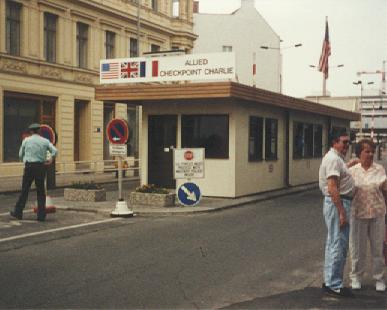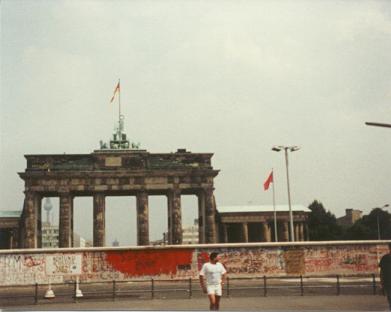A Reader's Guide To...
Destination: Berlin
1. What was Berlin like in 1988?
Berlin was an occupied city. At the end of World War II, the four allies—the
Americans, British, French, and the Soviet Union—partitioned the city,
each responsible for administrating their section and for rebuilding. The
Soviet partition became East Berlin. At first, right after the war, they ran
checkpoints to monitor the flow of personnel movement between the sectors.
In 1961, they built the Berlin Wall, which separated the East and the West
parts of the city.

Checkpoint Charlie, 1988

Brandenburg Gate, 1988
In 1988, Berlin was still surrounded by a wall. There was a
strong American, British, and French presence in the Western part of the city.
In 1987, Rudolph Hess, the last occupant of Spandau Prison (which was in the
British sector of the city) died.
2. What is Berlin like today?
A wall no longer surrounds Berlin. Free access is to entire city is afforded
to everyone. Berlin thrives not only as a tourist site but as the capital
of a united Germany.
3. What is there to visit in Berlin?
There are so many places I can suggest. There’s the Checkpoint Charlie
museum, near where Checkpoint Charlie once stood. On the Unter Den Linden
Strasse you can find Brandenburg Gate and the Tomb of The Unknown Soldier
along with many other historical landmarks. You can also visit the Berlin
Zoo and take a walk down the modern Kurfurstendam. You can visit Charlottenburg
Palace, where nearby you can go through an Egyptian museum that features the
bust of Nefertiti. In the eastern part of Berlin you can visit Treptow Park,
a Soviet war monument—and that’s just scratching the surface.
There’s more to see and do, but those are some of the places I’ve
been.